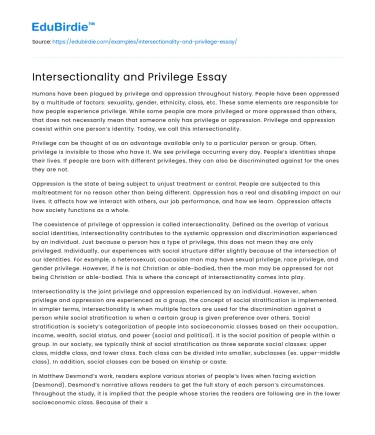Humans have been plagued by privilege and oppression throughout history. People have been oppressed by a multitude of factors: sexuality, gender, ethnicity, class, etc. These same elements are responsible for how people experience privilege. While some people are more privileged or more oppressed than others, that does not necessarily mean that someone only has privilege or oppression. Privilege and oppression coexist within one person’s identity. Today, we call this intersectionality.
Privilege can be thought of as an advantage available only to a particular person or group. Often, privilege is invisible to those who have it. We see privilege occurring every day. People’s identities shape their lives. If people are born with different privileges, they can also be discriminated against for the ones they are not.
Save your time!
We can take care of your essay
- Proper editing and formatting
- Free revision, title page, and bibliography
- Flexible prices and money-back guarantee
Oppression is the state of being subject to unjust treatment or control. People are subjected to this maltreatment for no reason other than being different. Oppression has a real and disabling impact on our lives. It affects how we interact with others, our job performance, and how we learn. Oppression affects how society functions as a whole.
The coexistence of privilege of oppression is called intersectionality. Defined as the overlap of various social identities, intersectionality contributes to the systemic oppression and discrimination experienced by an individual. Just because a person has a type of privilege, this does not mean they are only privileged. Individually, our experiences with social structure differ slightly because of the intersection of our identities. For example, a heterosexual, caucasian man may have sexual privilege, race privilege, and gender privilege. However, if he is not Christian or able-bodied, then the man may be oppressed for not being Christian or able-bodied. This is where the concept of intersectionality comes into play.
Intersectionality is the joint privilege and oppression experienced by an individual. However, when privilege and oppression are experienced as a group, the concept of social stratification is implemented. In simpler terms, intersectionality is when multiple factors are used for the discrimination against a person while social stratification is when a certain group is given preference over others. Social stratification is society’s categorization of people into socioeconomic classes based on their occupation, income, wealth, social status, and power (social and political). It is the social position of people within a group. In our society, we typically think of social stratification as three separate social classes: upper class, middle class, and lower class. Each class can be divided into smaller, subclasses (ex. upper-middle class). In addition, social classes can be based on kinship or caste.
In Matthew Desmond’s work, readers explore various stories of people’s lives when facing eviction (Desmond). Desmond’s narrative allows readers to get the full story of each person’s circumstances. Throughout the study, it is implied that the people whose stories the readers are following are in the lower socioeconomic class. Because of their status, the evictees are oppressed by authority figures. Many of the families are oppressed in more ways than one. The study reflects people of various ethnicities, genders, and religions (Desmond). Ultimately, the evictees’ social class is the root of their oppression.
Philippe Bourgois’ fieldwork focuses on the second-generation Puerto Rican community living in El Barrio at the height of the “crack economy” boom in the late 1980s (Bourgois). His study on the impoverished community located in East Harlem, New York, features the intersectional issues of gender, class, race, immigration, nationality, etc. His work also demonstrates the brutal cycle of cultural and political oppression, an inescapable pattern that deprives the community of any opportunities for better lives. The people Bourgois befriends in El Barrio are not only oppressed by society, but by their community. Facing oppression from outside El Barrio, their secluded neighborhood grows its types of privilege to combat the outside pressures (Bourgois).
Social stratification is a group’s experience with privilege and oppression. In Salvador, Bahia, in northeast Brazil, residents are experiencing race-based mass evictions and forced displacement due to an urban revitalization (Perry). At the forefront of the battle, anthropologist Keisha-Khan Perry introduces readers to a female-led grassroots movement fighting for their town as well as their right to be leaders. The protagonists of Perry’s work are poor, black women. These women are already facing oppression in their everyday lives. Perry goes on to highlight how these black women in poor urban neighborhoods in Salvador have made social and political spaces for themselves while also developing a greater notion of cultural belonging and citizenship rights (Perry 128).
Privilege and oppression have been prevalent in human history for thousands of years. An individual can be privileged and oppressed by sexuality, gender, race, class, etc. With that said, where privilege and oppression collide within a person’s identity is called intersectionality. Anthropologists’ definition of intersectionality as the overlap of privileges and oppressions only applies to individual experiences. When the intersection of privilege and oppression affects a group, this is known as social stratification. While everyone is uniquely affected by privilege and oppression, how we live and are perceived is affected by more than just our identities, but rather where our identities fit within social stratification, too.






 Stuck on your essay?
Stuck on your essay?

